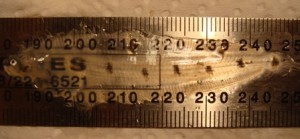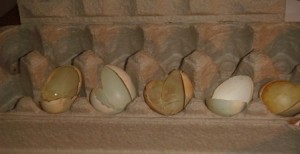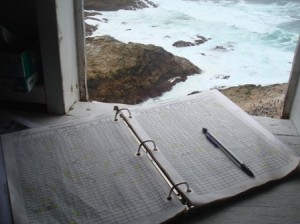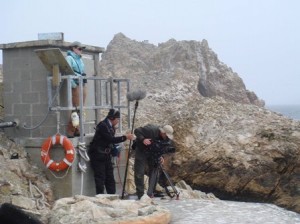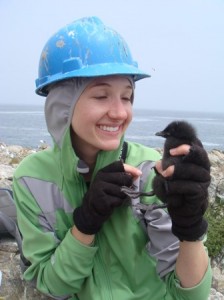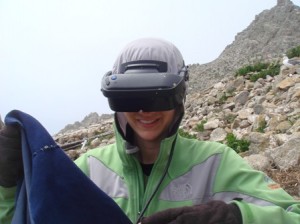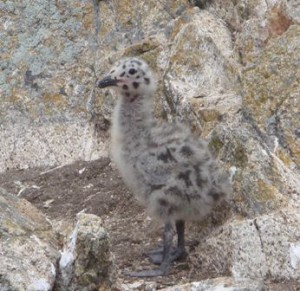Phew! The last 24 hours have been so busy! (You may be noticing a theme…we’re always busy out here.)
Rhino netting last night took a little bit longer than the night before. We were out until around 10:30 netting rhinos, and my job last night (as opposed to the night before, when I was the fish collector) was bird catcher, so my primary responsibility was removing birds from the net. I still don’t have any pictures of Rhinocerous Auklets (hopefully tomorrow), but they are strong birds, and they like to bite, hard, if you don’t watch out. So, because this is a learning process, I have plenty of scratches, and one bruised fingernail (I wasn’t kidding when I said they bite hard) to show for it, but it was super fun.
After we closed the net, we went in to ID all of the fish we got. The majority of them were Greenling, again, but last night we also got a number of these clear, gelatinous flat fish–a mystery!
We ended up just calling them juvenile flatfish. Juvenile fish are often clear like this, and several of the fish had the eyes on the same side, indicative of a flatfish, while others had eyes still undergoing the migrating process. Regardless of what they really are, they don’t look very nutritious.
To answer a question my mom asked, yes, we are taking the fish away from the bird, and therefore the chick as well. To minimize this, we mistnet in a different location each night, so the same bird is really unlikely to be caught twice in any ten-day period. In addition, some rhinos may make second foraging trips after we’ve released them, but there’s no way to measure that.
After ID-ing the fish, circa midnight, we went to the Coastguard House for a demonstration of how to properly process the dead eggs that the fish and wildlife people came here to start working on yesterday.
Kevin and Cathy gave us a pretty neat demonstration of what they do with all the eggs, teaching us, since we will keep the project going once they leave (which they just did). To process the egg, they cut a pretty small hole in the top, and then dump/scoop out all the contents (I have some pictures of this, but it’s pretty gross looking, and smelling, too). As you can see, they ultimately collect the shells, and the whole process is very delicate and precise, so you can end up with such intact samples.
This morning, I got up early to get my Murre attendance done before the boat landing, which happened around 9:30.
Murre attendance is exactly what it sounds like. Here’s a picture of the data sheets I fill out each day–total there are four or five sheets like this, and each day I fill out one row. I monitor whether birds are present at their sites, whether they have chicks/eggs, and whether or not banded birds are breeding/hanging out in my plot.
The boat landing today was for the Quest film crew, a PBS show, and a contingent of radio people from NPR member station KQED, which has a special science-oriented program they do every week, or something like that. Apparently, these two groups have been waiting almost 3 years to get permission to come out here–permits to get on to the island are pretty hard to get, and there is definitely a waiting list.
In total, the radio and film people brought six more people on to the island, by far the most that have been here since I got here. They spent the day with Russ, walking around the island and filming. The focus of their show was the science that is going on here, so they spent a lot of time filming us doing our daily activities. Jordan and I got filmed pretty extensively working with Cassin’s Auklet chicks, and we also got interviewed for the radio show, so we’ll have to see if anything with us makes it into the final cut!
The Fish and Wildlife people, the internet guy, and the film/radio crew all left this afternoon, on a boat, so we’re just back to the six of us on the island.
Today, in addition to murre attendance and daily chick checks, I had to my Pigeon Guillemot breeding survey. In order to mix things up a little bit, Caitie came around with me on that, and then she took me on her regular afternoon stuff, the Rhino Cam.
We had quite a few PIGU chicks to process today, meaning weigh and spraypaint (we spraypaint them to identify chick 1 versus chick 2 in a clutch), so it took kind of a while.
Some of the chicks are getting very large–they increased in weight by over 100 grams since my last check five days ago, which is quite a lot of weight gain, considering they only weigh about 250 grams now anyway.
Now, on to the Rhino Cam, which is something I have never done before.
The Rhino Cam is used to examine rhinocerous auklet chicks in natural burrows and crevices, rather than the artifical boxes that we’ve built for them. This is important, because not only does it give us more information about the population size and breeding success off the rhinos on the island, but it also lets us examine breeding success of birds that are never touched or handled.
As you can see in the picture, step one of working the rhino cam is to put on this cool eye cover thing, which is as neat as it looks! Inside the eye piece is a small screen, so once you put it on, you can see whatever the small camera is pointed at, right in front of your face.
Step two of working the camera is to put this pillowcase (hood) over your head, to block out all excess light, so you can see a better piccture. Then, you snake the camera down the burrow, looking for birds.
Getting the camera into the right spot can be really difficult. Many of these burrows branch multiple times, have rocks blocking part of them, or simply twist at very odd angles. The camera rope is really long, and it can be frustrating to twist and jerk the rope in exactly the right way to get the camera to go down the correct burrow.
Anyway, I successfully found on rhino chick, and he was really cute sitting all the way back in his burrow all by himself.
On a final note, look how big the gull chicks are getting! Most of them are up and walking, or running, around by themselves, and they stand to about shoulder-high on an adult.
More rhino netting tonight, and then hopefully some sleep! Having all of these boats and extra people on the island has been exhausting, since we have to work extra hard to make sure no one walks off the path or into a restricted area.
It has been fun, however, getting some variety in our routine.
More later!
Best,
Eleanor

